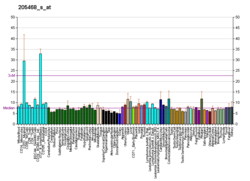IRF5
L'IRF (pour « Interferon regulatory factor 5 ») est une protéine de la famille des facteurs de régulation de l'interféron, avec un rôle de facteur de transcription. Son gène est IRF5 situé sur le Chromosome 7 humain.
Rôles
[modifier | modifier le code]il augmente l'expression des sous-unités es interleukines 12 et 23 et diminue celle de l'interleukine 10[5].
Il favorise la résistance à l'insuline et modifie la répartition des graisses[6].
Son inhibition pourrait améliorer la cicatrisation cardiaque après un infarctus du myocarde[7].
Dans l'athérome, il aurait un rôle pro-inflammatoire et inhiberait l'efférocytose[8].
Notes et références
[modifier | modifier le code]- GRCh38: Ensembl release 89: ENSG00000128604 - Ensembl, May 2017
- GRCm38: Ensembl release 89: ENSMUSG00000029771 - Ensembl, May 2017
- « Publications PubMed pour l'Homme », sur National Center for Biotechnology Information, U.S. National Library of Medicine
- « Publications PubMed pour la Souris », sur National Center for Biotechnology Information, U.S. National Library of Medicine
- Krausgruber T, Blazek K, Smallie T et al. IRF5 promotes inflammatory macrophage polarization and TH1-TH17 responses, Nat Immunol, 2011;12:231–238
- Dalmas E, Toubal A, Alzaid F et al. Irf5 deficiency in macrophages promotes beneficial adipose tissue expansion and insulin sensitivity during obesity, Nat Med, 2015;21:610–618
- Courties G, Heidt T, Sebas M et al. In vivo silencing of the transcription factor IRF5 reprograms the macrophage phenotype and improves infarct healing, J Am Coll Cardiol, 2014;63:1556–1566
- Seneviratne AN, Edsfeldt A, Cole JE et al. Interferon Regulatory Factor 5 controls necrotic core formation in atherosclerotic lesions by impairing efferocytosis, Circulation, 2017;136:1140-1154





